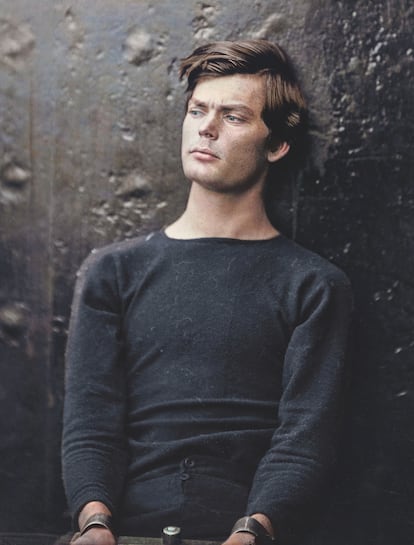Fallen soldiers on the Gettysburg battlefield, in a digitally colored photo from the book 'The Color of Time' Library of Congress
The dead seem more dead in color, but the kisses (the famous sailor and nurse in Time Square on the day of victory over Japan) are also more real, and the Nazis, and General Custer, and Darwin, and neither say Rasputin.
Two hundred black and white photographs, many of them very famous, iconic, now digitally colored, make up the book
El color del tiempo
,
una historia visual del mundo 1850-1960
(Desperta Ferro, 2021), the work of the Brazilian artist specialized in coloring digital Marina Amaral and the historian Dan Jones, a great popularizer and author of, among other titles, the notable
The Templars: Rise and Fall of the Warriors of God
(Ático de los Libros, 2018).
More information
Get the colors out of Hitler
How computers credibly color old black and white photos
The photos here do not go as far back as the Knights of the Temple - although it would be fascinating to see one, colored or not, of Jacques de Molay at the stake (1314) - and the oldest are from the mid-19th century, with both portraits of Napoleon III and Queen Victoria, which also colored seem more real and much closer people. Two other photos lead us to one of the landmark episodes of the time, the Crimean War (1853-1856). One, the face of history, is a famous portrait of Royal Artillery Captain Thomas Longworth Dames, who fought at Alma, Inkermann and Sevastopol, photographed in 1855 by Roger Fenton: he poses very elegant, and more in color, in his uniform with dolman, high leather cap, gloves, saber and many alamares and laces. The reverse of that photo, the cross, is, as you turn the page, the impressive panorama,also from Fenton, from the Balaclava valley where, in that same war, took place on October 25, 1854, the famous last charge of the British Light Brigade against the Russian guns immortalized by Tenysson. The color makes you have the sensation of entering that place where there is nothing, no horses, no riders, no gunpowder or glory, but only dozens of Russian cannonballs scattered on the ground.
“Photography operated during its first century of existence almost exclusively in black and white”, the authors justify their work, “and because of this our perspective of the past is partial and off”. Thus, the book (which some photography purists may consider an attack on their art, an open debate by the new technologies that allow almost magical coloring), "constitutes an attempt to return the brightness to a desaturated world", to "allow us to contemplate in a new light a sensational and transformative time in human history ”. The meticulous digital coloring of some images has required up to a month of work, verifying every detail. The authors acknowledge despite all their enthusiasm that "some things may have to remain black and white forever."
In the more than four hundred pages of the book, with a lot of very interesting information about the history of photography, the photos, selected from more than ten thousand, follow one another in a chronological journey in which famous images alternate with unexpected ones. There is, for example, the hippopotamus
Obaysch
gifted by the viceroy of Egypt and made a star of the Regent's Park zoo in London.
The information that accompanies the colored photos gives them a wonderful context and is always juicy (Dan Jones' pleasant hand points out, for example, in a portrait of Alexander II his high-voltage romance with Princess Dolgorukaya and quotes the Tsar's letter: seeing before my eyes, in bed, without panties ”).
Here it is recalled that the photograph was taken from inside the cage, risking his skin, since the hippopotamus was quite fussy, Juan Carlos María Isidro de Borbón y Braganza, Carlist pretender to the throne of Spain.
Confederate Lewis Powell, one of the conspirators to assassinate Lincoln, in jail.
Colorized from the photograph of Alexander Gardner taken before his hanging in 1865.
Of the portraits that mark the journey through the nineteenth and twentieth centuries (Dreyfus, Marx, Edison, King Faisal, Einstein, Howard Carter with the, now, golden Tutankhamun, the brave and beautiful aviator Amelia Earhart, Michael Collins in uniform Ireland green, Pancho Villa with a red tie, Churchill wielding the Thompson machine gun) highlight that of Darwin, whose colored face brings it closer to us until it seems that it was made yesterday, as happens with the famous Lincoln by Alexander Hesler; or that of Kaiser Giuillermo II, arrogant until saying enough; Sensational Sarah Bernhardt in flamboyant theatrical attire, and spy Mata Hari: both photos seemed to be crying out for color. Custer in color is as he was last seen alive that bloody day in Little Bighorne; Twenty pages later, his nemesisSitting Bull seems to emerge from his own color portrait to give him one last look of strained defiance.
But if it is necessary to highlight two portraits that with the color acquire a new exceptional close drama, they are that of the desperate day laborer Florence Owen, the famous emblematic photo of the great depression taken by Dorothea Lange in California, and the Alexander Gardner of the Confederate Lewis Powell , one of the assassins of the conspiracy against Lincoln, in jail (later they would hang him) and who looks like a very handsome member of the Actor's Studio.
Group photos also: in the one of Butch Cassidy's and Sundance Kid's bandit party, the coloring allows us to appreciate the great resemblance of Cassidy not to Paul Newman but to Val Kilmer ...
Archduke Franz Ferdinand, heirs of the Austro-Hungarian Empire assassinated in Sarajevo, in a colored portrait from the book 'The Color of Time'.
Many photos capture historical moments. Colored, that of the ANZAC troops charging into Gallipoli is sensational, that of the beheaded on a street in China in 1911 terrible, and that of Scott's expedition ship to Antarctica seen from an ice cave takes on magical tones that they remember that in the great white there was also color. As there was on the Eiffel Tower under construction: it was initially bright red! The selection includes stupendous contrasts such as the polychrome hell of Pearl Harbor followed by an unusual placid, almost erotic, bathing of dozens of naked American soldiers in a river of Guadalcanal, their tan bodies with white markings framed by the green of the jungle. Also worth noting, as appropriate, is that of the nurse wearing a mask during the Spanish Flu of 1918:a close-up of a shocking news.
Many dead in this graphic journey through history: those on the Gettysburg battlefield, now so close, those of the Paris Commune numbered in their coffins, the tattered German soldier in a trench, the disfigured corpses of Mussolini and Clara Petacci full color.
It is also shocking how dangerous and current the Nazis are in color.
The famous photo of the Warsaw Ghetto uprising brings us into the drama of the Holocaust in exactly the reverse way as Spielberg did in
Schindler's List.
The coloring work is generally extraordinary, although, to criticize, the famous decoration of the Red Baron, the
Blue Max,
has a too pale tone on the chest of the hunting ace ...




/cloudfront-eu-central-1.images.arcpublishing.com/prisa/56FQEM4G6NDS5LIUHQJBCIVXEI.jpeg)










